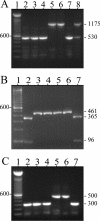Application of sensitive and specific molecular methods to uncover global dissemination of the major RDRio Sublineage of the Latin American-Mediterranean Mycobacterium tuberculosis spoligotype family
- PMID: 18234868
- PMCID: PMC2292928
- DOI: 10.1128/JCM.02231-07
Application of sensitive and specific molecular methods to uncover global dissemination of the major RDRio Sublineage of the Latin American-Mediterranean Mycobacterium tuberculosis spoligotype family
Abstract
The Latin American-Mediterranean (LAM) family of Mycobacterium tuberculosis is believed to be the cause of approximately 15% of tuberculosis cases worldwide. Previously, we defined a prevalent sublineage of the LAM family in Brazil by a single characteristic genomic deletion designated RD(Rio). Using the Brazilian strains, we pinpoint an Ag85C(103) single nucleotide polymorphism (SNP) (screened by restriction fragment length polymorphism [RFLP] analysis) that correctly identified all LAM family strains. Importantly, all RD(Rio) strains concomitantly possessed the RD174 deletion. These genetic signatures, along with a newly developed multiplex PCR for rapid differentiation between "wild-type" and RD(Rio) strains, were then used to analyze an international collection of M. tuberculosis strains. RD(Rio) M. tuberculosis was identified from four continents involving 11 countries. Phylogenetic analysis of the IS6110-RFLP patterns from representative RD(Rio) and LAM strains from Brazil, along with all representative clusters from a South African database, confirmed their genetic relatedness and transcontinental transmission. The Ag85C(103) SNP RFLP, as compared to results obtained using a PCR method targeting a LAM-restricted IS6110 element, correctly identified 99.8% of LAM spoligotype strains. Together, these tests were more accurate than spoligotyping at categorizing strains with indefinable spoligotypes and segregated true LAM strains from those with convergent spoligotypes. The fact that RD(Rio) strains were identified worldwide highlights the importance of this LAM family sublineage and suggests that this strain is a global threat that should be specifically targeted by public health resources. Our provision of simple and robust molecular methods will assist the evaluation of the LAM family and the RD(Rio) sublineage.
Figures

References
-
- Bhanu, N. V., D. van Soolingen, J. D. van Embden, L. Dar, R. M. Pandey, and P. Seth. 2002. Predominace of a novel Mycobacterium tuberculosis genotype in the Delhi region of India. Tuberculosis 82105-112. - PubMed
-
- Bifani, P. J., B. Mathema, N. E. Kurepina, and B. N. Kreiswirth. 2002. Global dissemination of the Mycobacterium tuberculosis W-Beijing family strains. Trends Microbiol. 1045-52. - PubMed
Publication types
MeSH terms
Substances
Grants and funding
LinkOut - more resources
Full Text Sources
Medical
Miscellaneous

